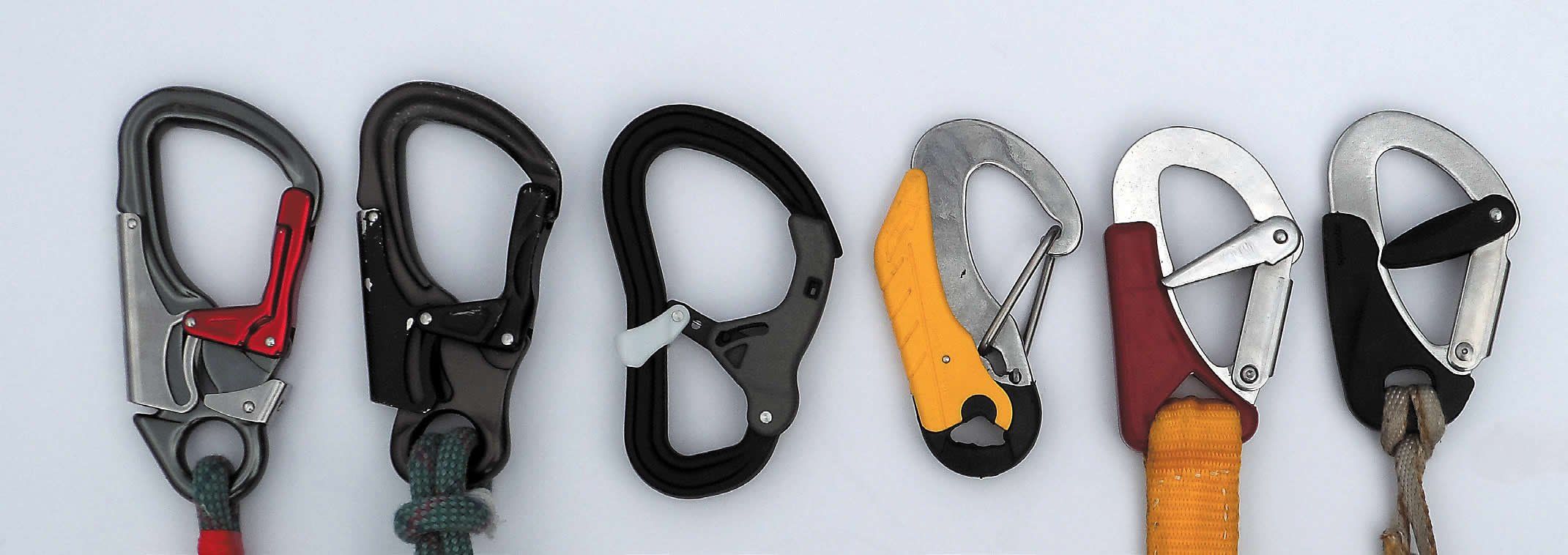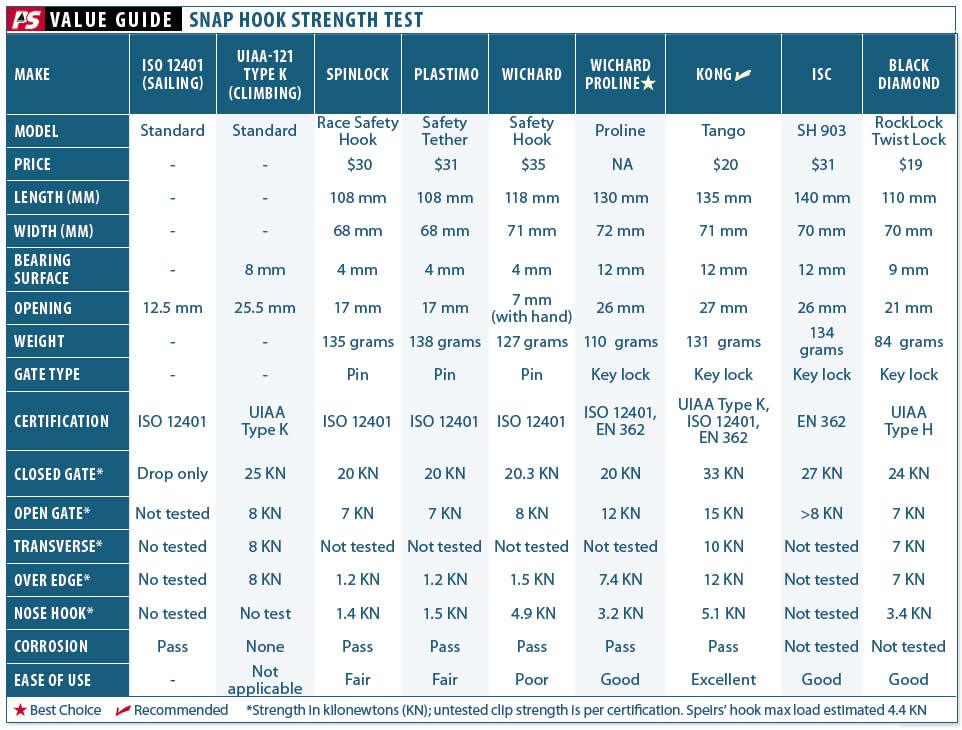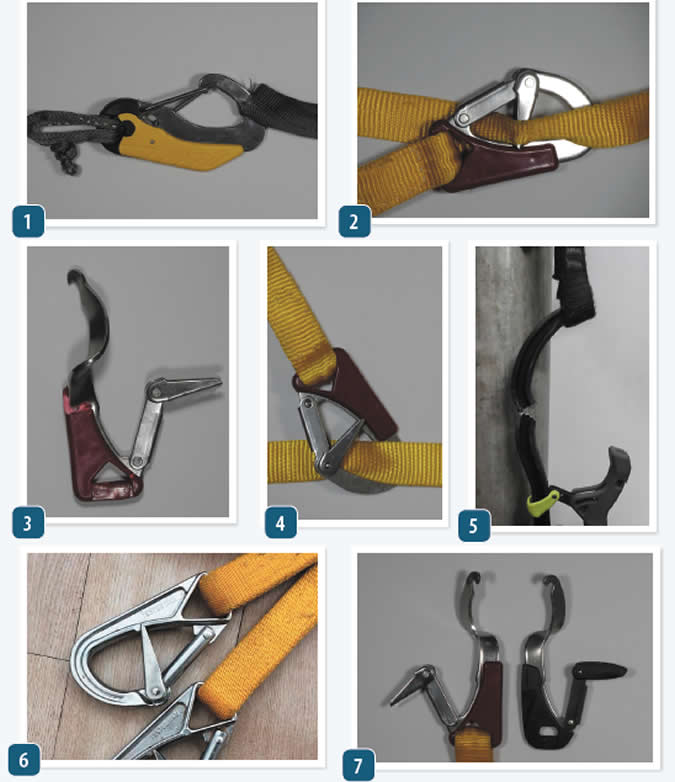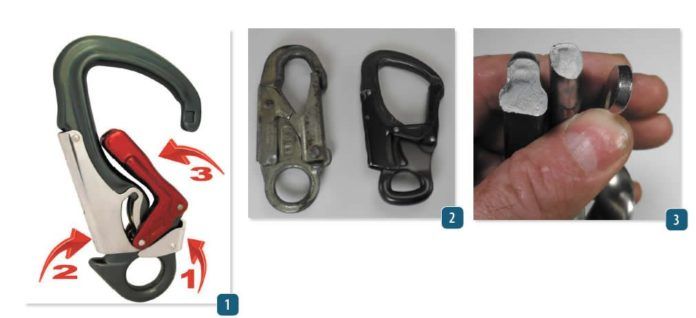On November 18, 2017, Simon Speirs, an experienced sailor, went overboard while at the bow assisting with a headsail change on a Clipper Round the World Boat CV30. It was blustery, with sustained winds of 20 knots, gusting to 40 knots. Shortly after he went overboard, his safety tether detached and he was separated from his boat. His body was recovered 34 minutes later. The cause of death has not been determined but drowning is the suspected cause. While such accidents are tragic, they offer a chance to re-evaluate equipment standards within a real-world context.
Great Britains Marine Accident Investigation Branch is currently investigating the events linked to Mr. Speirs death, but the most obvious contributing factor was the failure of the Gibb-style locking snap hook on Speirs safety tether. The snap hook (also called a connector, safety clip, safety hook, or carabinier) was located at the distal end of the tether and used to connect Speirs to the jackline, a length of webbing stretching from the midship to bow. The snap hook was recovered along with the harness and tether still attached to Speirs body. The snap hook was intact, but it had opened like a paperclip before releasing from the jackline. The MAIBs final report is not expected for months, but in January it issued a safety advisory concerning the use of safety tethers, accompanied by images of what can happen to a Gibb-style snap hook when it becomes trapped under a cleat or other fixed object and loaded from the side (see the adjacent story MAIB Safety Advisory Warns Sailors).

Photos by Drew Frye
Very few other details regarding the accident have been released. According to the race founder Robin Knox Johnston, Speirs was working on the bow during a sail change when he and a crewmate were washed over board. The crewmate, who was attached to the boat with the short leg (3 feet) of his two-legged tether, quickly clambered back aboard. However, Speirs, who was attached with the longer leg (6 feet), could not self-rescue. Crewmates were trying to bring him back on board when they heard a loud crack and he was suddenly separated from the boat.
The MAIB advisory describes a scenario in which leverage was applied to the side of the snap hook, but our own testing suggest nose-hooking-a cause well known in rock climbing circles-also might have played a role (see photos 3 and 7 in the adjacent story, Putting Hooks Under Pressure). Nose-hooking is when something gets lodged in the nose groove, which can concentrate loads on the weaker sections of some hook designs such as the Gibb. It is quite possible that the failure of Speirs snap hook was caused by a combination of both side loads and nose-hooking: the carabiner became trapped under a bow cleat, was bent enough to open the gate and allow the webbing to slide to the nose hook, after which the loaded snap hook twisted out nearly straight.
To our testers surprise, off-center loads don’t have to be great to bend a snap hook open. In our tests, the Gibb-style hooks like the Spinlock Race Clip that Speirs was wearing began distorting under axial (side) loads as light as 275 pounds. At 300 pounds the hooks were fully open. As a comparison, carabiners used by rock climbers like the Kong Tango sustain loads up to 2,700 pounds before failure, and about 1,160 pounds when nose hooked. For more details on the testing, see How We Tested on the adjacent page.
What We Tested
We tested the most widely available snap hooks in North America, two of which are based on the Gibb snap hook, a double-action locking hook. Introduced to the sailing market more than thirty years ago, the Gibb-style hook has been gradually modified over the years to be lighter, making them less resistant to the side loads cited by the MAIB as a possible cause of failure (see photo 6, Putting Hooks Under Pressure). The test hooks included three flat plate stainless-steel models-the Plastimo Double Acting Safety Hook (a Gibb design), the Spinlock Race Hook (a Gibb design), and the Wichard Double-Acting Safety Hook. We also tested three aluminum alloy hooks that are also used in climbing: the Wichard Proline Snap Hook (also called the ProSnap), the Kong Tango, and the ISC SH 903 Triple-Acting Snap Hook.
Observations
The nose hook test results were telling. The Spinlock Race Hook, the same type that Speirs was wearing at the time of the accident, failed at around 300 pounds. The Wichard Double Action Safety hook cut through the webbing at 900 pounds and tore out at 1,200 pounds. (When we repeated the test using steel cable, it would not stay in the groove. Testers concluded that nose hooking the Wichard Double Acting Safety Hook on a wire is impossible.) It is also impossible to nose hook any the key-lock carabiners on wire, and more difficult to hook them on webbing.
The Kong Tango was extremely strong, holding 1,160 pounds before failing. It is worth noting that it is very difficult to impart loads greater than 1,000 pounds on any hook when it is combined with an energy-absorbing safety tether (See Building a Custom Safety Tether, December 2017.)
Our search for a strong snap hook led us to the world of climbing, where the equivalent to sailing tethers are via ferrata lanyards. Via feratta (literally iron roads) are steel safety cables and cable ladders initially introduced to help troops traverse the Alps, but are now popular among hikers and climbers. The climber attaches a safety tether to the cables using special carabiners designated as UIAA Type K. Carabiners that meet this designation must open wider than most sailing tether clips (to accommodate rails) and can withstand a side impact of 1,800 pounds. They require a simple one-handed self-locking mechanism and are about 25 percent stronger than common climbing carabiners. The only carabiner used on sailing tethers that meets all of the Type K requirements is the Kong Tango.
We found carabiners with grooved noses (used to secure the gate) frequently caught on the webbing. Climbing carabiners have generally switched to key lock gates, in which a bulge on the gate fits into a slot in the nose, making for smoother clipping. To completely avoid webbing snags, climbers often pre-rig carabiners for clipping in. Some ocean sailors go one step further and pre-install short tethers at key work stations such as the base of the mast.
To comply with standards set by World Sailing, the sports global governing body, safety tethers and their hooks must pass a drop test required by ISO 12401. The drop test is a fair measure of the tethers ability to absorb straight-line shock. However, it does not address side loads or measure general robustness as is done with climbing tethers and hooks. In addition, ISO 12401 does not test for off-axis loads or strength with the locking gate open. Adopting the more stringent, UIAA-121 type K standards, which incorporate off-axis testing, would produce snap hooks that better be able to survive assaults from all directions.

Good Clip-In Habits
Nose-hooking is particularly common when clipping to webbing, as slack webbing tends to hang up in the gate area. This is one reason virtually all new self-locking carabiner designs have done away with the pin-and-groove gate and switched to key-lock mechanisms. Always confirm that tether carabiners are fully locked.
Also, beware of webbing getting caught on the latch mechanism. Testers found that if the tether is pulled along the jackline webbing in one direction, and then the sailor crosses the jackline while reversing direction, the Gibb-style hooks tends to snag in webbing jackline. (Testers found a 1-in-4 chance of this occurring with some webbing). If the tether is then tugged, there is a risk that the gate will penetrate the webbing and lodge deeper. This problem is widely reported from the field, and some sailors have gone so far as to insert either rings, carabiners, or shackles on the jackline and clip to those. The Spinlock Race Hook, which features smoother edges than the other Gibb designs we tested, did not suffer this problem.
The snap hooks effectiveness is often determined by how wisely you use it. Ideally, you should only clip into a jackline or well-reinforced padeye designated for that task. Avoid stanchions, life rails, toe rails, lifelines, and slotted aluminum rails. All of these hard points can put excessive loads on the weaker parts of the snap hook, causing it to fail. Remember that if you use a two-legged tether, be sure not clip your spare tether to the harness.
Short jacklines or padeyes at work stations, when used with the short tether legs can avoid many of these problems, specifically cross loading. For example, a short, a permanently rigged tether at the mast base often makes sense. For anchors, a well-backed u-bolt rated to 4,200 pounds is a budget options. Any u-bolt or padeye must be large enough to allow the carabiner to flip around easily.
Petzl offers more examples of risky clip-in scenarios: https://goo.gl/JMXiSJ
Spinlock Race Hook
A descendent of the Gibb hook, this hook is demonstrably weak when nose hooked, and would clearly be vulnerable when lodged beneath the horn of a cleat or a hard point as described in the MAIB advisory. The reason, of course, is that it, like the other newer iterations of the Gibb, is stamped from thin stainless sheet. The hook measured 4 millimeters thick, and during the nose-hook tests, it crumpled at 250-300 pounds of load-only 5 to 7 percent of its rated strength-when the load was on slightly off balance to one side. When side-loaded, it was two to four times weaker than the other snap hooks in our test. We also discovered that it could be unlocked by stepping on it with a twisting motion. During both the load testing and during the field tests of the ease of clipping and unclipping, testers observed that the gate pin groove frequently and tenaciously snags on webbing and wire lifeline cables. The thin edge profile can potentially damage ropes, or even cut webbing. When it was loaded to 1,200 pounds in one pull test, the hook sheared through a steel cable rated for 4,200 pounds.
Bottom line: The all-stainless construction makes it nearly corrosion-proof, but that does not make up for inherent weakness and snag-prone clipping. Not recommended.
Plastimo Double-Action GIBB Safety Hook
This hook is nearly identical to the Spinlock hook, with a metal gate instead of plastic. The gate also has much sharper corners, which make it more prone to snagging. Like the Spinlock, the Plastimo was vulnerable to light loads when nose hooked. Additionally, both the hook and gate proved more likely to jam in the webbing and harm the jacklines webbing (see photo 2 in Putting Hooks Under Pressure). In our tests, however, even when the gate was snagged, the hook did not completely cut through the webbing, because as load increased, the gate would flip back and the webbing would slide back up to the basket (see labeled photo page 8). When evenly loaded at the basket in line with the longest, roughly vertical axis, it was weaker than the Spinlock. The gate was also harder to manipulate than the Spinlock as well.
Bottom line: Not recommended.
Wichard Double-Action Safety Hook
Made of the same thickness (4 mm) metal as the Gibb and Spinlock hooks, the improved geometry of this hook makes it considerably stronger, over three times as strong if nose hooked. When nose-hooked on webbing, this was the only carabiner to cut through the webbing. However, this occurred at loads higher than those that caused all other carabiners to bend open and fail. The gate is stiff, and our testers with weak hands found it nearly impossible to open with one hand, especially several times in succession or in cold or wet conditions. A few needed their dominant hand or both hands to open it, both bad ideas on a boat where a firm grip on the boat is the top priority. Because your fingers block the gate opening, the practical opening size of the gate when trying to clip in is only 7 mm, which 60 percent of the size required by ISO 12401. Clipping and unclipping from webbing was awkward at best, the most difficult of the group.
Bottom line: Tough sailors with small strong hands might find no problem opening this hook, but the hooks narrow opening during use and small bearing surface are problemematic.
Wichard Proline Safety Hook
Introduced January 2016, the Proline carabiner closely resembles via ferrata carabiners in concept. It easily meets the World Sailing minimum (ISO 12401), but because it is focused on the marine market it lacks UIAA-121 Type K approval for climbing. However, PS testing, including side loading, suggests it would meet the Type K requirements if submitted to a certified testing agent. They are easily managed, even when wearing gloves, and the gate mechanism is highly resistant to accidental opening. They are anodized to combat corrosion, but the gate can jam with grit or scale and not latch completely; occasional cleaning will easily prevent this. They are quick to attach or detach, even with gloves, though not as lightning fast as via ferrata carabiners like the Kong Tango. The V-shaped nose made it easier to clip webbing and jacklines laid tightly along the deck
Bottom line: Strong, light, secure and easy to manipulate, this is our Best Choice in tether clips. To prevent copycat products from entering the market, Wichard only sells this with a tether, starting at $200.
Kong Tango
The product of a cross-pollination between rock-climbing technology and sailing, these rugged carabiners meet not only the World Sailing standards, but also the applicable standards for rock climbing, via ferrata climbing, fire-fighting, and similar occupations with a high risk of falling. The gate will fit around one-inch railings, and the key-lock gate makes nose-hooking on wire impossible. Testers found nose-hooking on webbing is unlikely. The strength, even when cross-loaded, far exceeds Gibbs-style hooks. Very similar to that used on industrial ANSI-rated snap hooks, the locking mechanism is the fastest to clip and the least-prone to snagging when removed. The lock is positive and reassuring, yet still easy enough to manipulate wearing gloves. There have been a few reports of neglected Tangos jamming due to corrosion of the locking mechanism. Well-maintained hooks, however, have been in-service for nearly a decade and remain like new. All aluminum carabiners should be rinsed occasionally with fresh water and the hinges lubricated with waterproof grease annually.
Bottom line: Backed by more than a decade in the field, the Kong Tango remains a good choice. We put it just slightly below the Wichard Proline in features. It is our Recommended hook and a very close second.
ISC SH903 Triple Action Snap Hook
Nearly identical in design and construction to the benchmark Kong Tango, the SH903 has several interesting features. The base near the eye protrudes, protecting the opening mechanism from contact when being dragged. There is also a unique triple-lock that makes accidental opening nearly impossible. We rate the ease of clipping about equal to that of the Wichard Proline. It is lightly easier to open bare handed, but significantly more difficult with heavy gloves. One tester with weaker hands struggled to make it work. As with the Proline, we’ve only had this clip in the field for a matter of weeks, but based on the accelerated corrosion testing, we expect it will be as durable as the Kong Tango. ISC also makes a very similar very fast single-acting carabiner, like the Kong Tango (SH 901). They are not certified under ISO 12401 but would likely meet the requirements.
Bottom line: This is a very secure carabiner. The only thing holding it back is lack of an IS0 12401 certification, which it would almost certainly pass.
ClimBing Snap-Hooks
Although they are not designated for marine use, climbing carabiners have been used in sailing for decades. One of our principal testers, Drew Frye is also a climber, and he uses these and other climbing gear in many onboard applications (see Ocean Tested: Rock-climbing gear, September 2012).
For those who want to further investigate climbing carabiners, here are just a few of the many UIAA type K carabiners available through climbing gear suppliers like REI: Petzl Vertigo Wire Lock, $24; Petzl Amd ($19); Kong Tango ($25); DMM Klettersteig ($21); Camp Horai ($30); Petzl Eashook; $32. To our knowledge, the Tango is the only climbing snap hook certified to meet the World Sailing ISO 12401 requirements.
Black Diamond Rock Lock (Twist Lock)
Lighter, stronger, and faster to clip than most of the carabiners in this group, climbing carabiners have a few downsides. Like the Tango, they benefit from regular lubrication. The Rock Lock carabiner is not fixed to the end of the tether, so it can flop around. Lashing it in place is easy, though. The lock and unlock motion is a twist rather than a squeeze; this simply takes getting used to. (ISO 12401 requires that the hooks be self-closing and that they can lock, but does not require automatic self-locking).
Bottom line: Some readers like these, and if you remember to lock them, they are very functional.
Black Diamond Rock Lock (Screw Gate)
The lightest and most economical of the group, screw-gate carabiners are well proven in rugged climbing environments. However, because the locking mechanism requires you to screw a knurled thumb nut over the gate, we did not include them in our table and cannot recommend them for general use. We include them because we found them to be a useful addition to fixed clip-in points at work stations. They can also be used to attach a semi-permanent tether at work stations near the mast, or other locations.
Bottom line: Safe if used properly and kept clean and lubricated. Beware of grit and salt getting in the screws, causing corrosion.
Conclusions
In our view, World Sailing should tighten its standards so that safety tether snap hooks meet UIAA-121 Type K tests, including all labeling requirements for test strength. The stronger Type K snap hooks are no more expensive than the flat plate stainless steel clips sailors are using now. Raising the standard will increase the general ruggedness and decrease vulnerability to bad clipping geometry.
It is important that any standard for gate-opening size take into account the obstruction caused by the users hand while opening. We would also like impact force included in the ISO 12401 tether standard, using a UIAA single rope as the baseline.
A sailor should be able to quickly release and reattach the tether from the harness. The current standard says the tether must be releasable, and Spinlock and other makers take this to mean the tether is capable of being cut with a knife (available separately). Some sailors wrap the lazy unused tether around their waist to keep it out of the way. To accommodate the unused tether and snap hook, harnesses should have a separate attachment point-preferably a metal ring-that is not used for any other purposes.
Although recreational sailors are not required to wear safety tethers, much less one that meets a specific standard, we would like to see chandleries voluntarily stop selling tethers and harnesses that do not comply with the World Sailing Offshore Regulations and ISO 12401. Rather than defending standards that don’t work, we should learn from what has been proven, adopting by reference wherever practical. Vendors and sailing organizations should work together to develop training materials and programs that specifically address the use of safety tethers.
Which clip do we like? In the end, it was a very close decision between the Kong Tango and the Wichard Proline. The Tango is faster to clip and stronger, and the Proline lighter, more resistant to accidental unclipping, and based on our initial look seems better armed against corrosion. Both are easy to use in the dark with gloves and strong enough to handle minor clipping errors. Either would be a reliable component in your safety tether.
Until something better comes on the market, we can’t see a reason to invest in the flat-stock stainless steel snap hook in our test. If you have a Gibb-style hook, you don’t have to ditch it right away. These hooks have thousands of miles behind them. However, be aware that if you do continue with them, you should take certain precautions.
Avoid using them on any padeye or fixed clip-in point that might allow for off-axis loads, and clip into jacklines with caution, making sure to avoid snags. We will be looking more closely at the tether (webbing) component in a future report and compare complete tether sets. If you can’t wait until that report, either the Wichard Proline or Kong Tango tether packages will serve well.


Bent and broken hooks, snagged and torn webbingthe range of failures astounded our testers.
- Thin bearing surface on the Wichard cut through the jackline.
- The Gibb-style hook was not difficult to snag. The latch cut the webbing.
- The plastic sheath broke on the Gibb hook bent over an edge as if snagged on a cleat.
- When reversing direction and crossing over the tether, the latch can catch on the jackline.
- The hot- forged Wichard Proline clip was more ductile than the Kong in our test.
- The original Gibb clip is more resistant to side loads.
- After about 1,110-pounds of load a nose-hooked Gibb (left) and Spinlock (right) bent into the same shape as did Speirs tether hook.







































